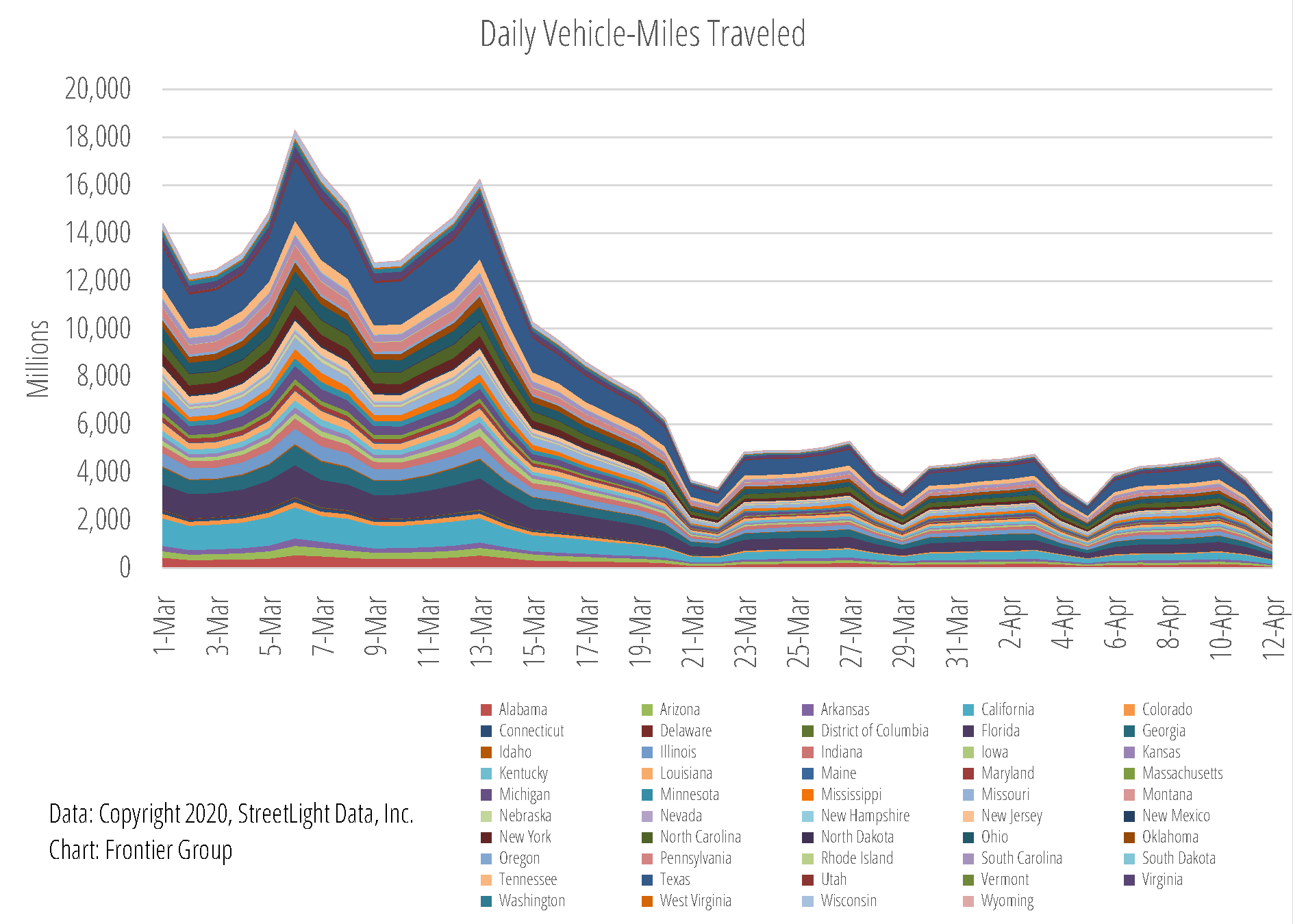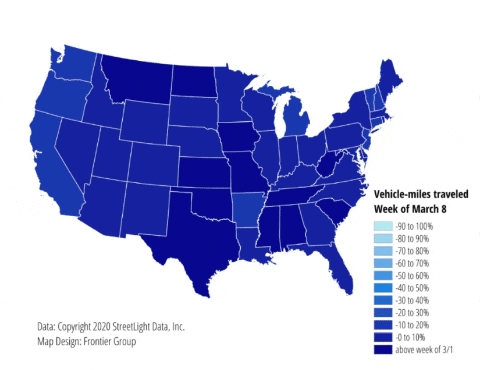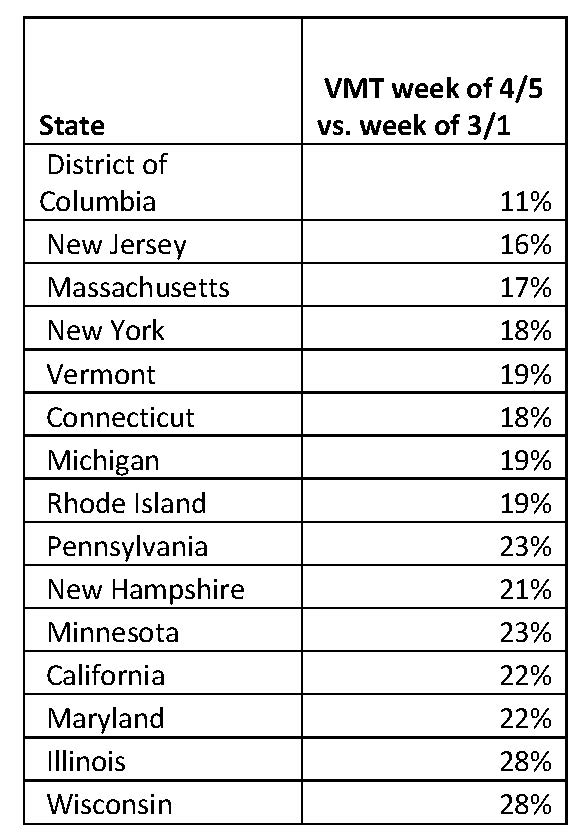
America on pause: Vehicle travel during COVID-19 and what comes next
Driving is down across America during COVID-19, but the trends vary from state to state. Our new blog post reviews which states saw the fastest drops in traffic and what the future might hold.
The COVID-19 crisis has felt surreal in many ways, but few aspects have felt quite so strange as the evaporation of car traffic from American cities. In my neighborhood of Boston, for example, one is just as likely to hear birdsong as car engines during the morning rush hour these days. A new analysis by the firm StreetLight Data, based on cellphone data, shows just how dramatic the drop in vehicle-miles traveled (VMT) during the COVID-19 outbreak has been. Household vehicle travel across the contiguous U.S. declined by 68 to 72 percent during the last two weeks in March and first week of April, compared with the first week in March.

Before launching a deeper dive into the data, some caveats. As with many new data sources being launched rapidly during the pandemic, the StreetLight data should be taken with a grain of salt. The data represent household-based VMT (omitting, for example, truck traffic) and the estimates of total VMT are at variance with some other sources of vehicle travel data published by state and federal agencies.[1] Nonetheless, the data provide a unique and intriguing picture of what has been happening on the roads during the pandemic, updated on a daily basis.
The data show that as the outbreak unfolded in early March, some states shut down faster than others. By the week of March 8 – the week the virus burst into national consciousness with suspension of the NBA season – vehicle travel was already down by 10 to 15 percent in states along the West Coast and in parts of the Northeast where concern about the virus took hold first. By the following week, the first after President Donald Trump’s declaration of a national emergency, vehicle travel was down nationwide by nearly half. And by the week of March 22, shutdown was functionally complete, with the number of miles driven nationally having fallen by two-thirds.

The District of Columbia has seen the most dramatic drop in home-based travel, with a whopping 89 percent decline. Other states that have experienced the most serious outbreaks or that locked down the most completely have seen declines in household vehicle travel of 75 percent or more.

While the drop in travel in some areas has been particularly intense, the data also show that the coronavirus lockdowns have been a truly national phenomenon. In Wyoming, which has experienced the slowest decline in driving, household-based VMT in early April was off by more than 60 percent.
The StreetLight Data website includes much more granular data – down to the county level – that is worth exploring.
So, what are we to take away from all this? The first conclusion is that COVID-19 has made a significant dent in vehicle travel and, along with it, in the negative side-effects of our dependence on cars, from air pollution to the loss of life and property in crashes. Assuming that vehicle travel remains at its current level for the rest of April, the COVID-19 crisis would result in at least a 5 percent decline in VMT for the whole of 2020.[2]
What happens next, of course, is anyone’s guess. It is possible either that vehicle travel will experience a dramatic resurgence once restrictions begin to be lifted or that the hangover from the crisis will lead to travel reductions for the foreseeable future.
Forces that might contribute to a rapid snap-back of car travel include cheap gasoline, pent-up demand for services that had to be postponed during the pandemic (hair styling, dog grooming, routine doctor’s visits, etc.), suspicion of the safety of public transportation, and possibly the replacement of some long-distance and international vacation travel with domestic travel by car.
On the other hand, it’s possible that at least part of the shift toward telework and services delivered over the internet will prove to be enduring, reducing the speed of the resurgence in travel demand. It’s possible that some of those who have taken up walking and biking in the last several weeks as a source of stress relief or as an alternative to public transportation will keep it up once restrictions are lifted. It’s virtually certain that some forms of social interaction – large sporting events or music festivals, for example – and the travel demand they generate will be slower to return than other forms of activity. And if the crisis brings with it a lasting economic recession, the effect of that decline on vehicle travel could be pronounced and long-lasting.
Nobody knows how all those factors will combine in the coming weeks and months. What is certain however, is that not only will total VMT change, but the characteristics of who is driving where, when, and for what purposes will change as well.
During a time of uncertainty, however, it’s important to keep our priorities straight. The most important thing today is to provide safe, accessible transportation for all who need it – especially first responders and essential workers. That means keeping trains and buses running, keeping roads in good repair, and providing safe places for people to walk and bike.
As the coronavirus pandemic winds down, it will be important to find ways to preserve some of the benefits of reduced vehicle travel in whatever our “new normal” turns out to be. Encouraging employers to continue some forms of telework, restoring confidence in the safety of public transportation, accelerating the transition to electric vehicles that can help to clean our air, and expanding access to bikesharing and other micromobility options are all steps that can contribute to preventing a dangerous and destructive resurgence of traffic and pollution.
Lastly, we need to keep our eyes on the prize when it comes to long-lasting investments in transportation infrastructure and not let a rushed demand for economic stimulus drive us to make bad decisions that will lock our unsustainable transportation status quo into place for decades to come.
The COVID-19 crisis has demanded many of our institutions to be nimble and flexible in ways they have never had to be before. As the pandemic continues, and especially as it winds down, it will be critical for policy-makers to keep their eyes open to changes happening on the ground and to look for opportunities to ensure that the transportation system that emerges in our “new normal” is better, cleaner and healthier than the deeply flawed old normal now receding into the rearview mirror.
Note: All data are Copyright 2020, StreetLight Data, Inc., used here with permission. We are grateful to StreetLight for making this data available to the public and to researchers.
[1] Specifically, the StreetLight estimate of VMT for March, which saw a dramatic mid-month decline in vehicle travel, exceeded the FHWA’s estimate for VMT in March 2019. In addition, validation of the model provided by SearchLight found good agreement with some published county-level VMT estimates but significant differences with others. Given the inconsistent quality of vehicle travel data collected by local, state and federal transportation agencies, it is difficult to assess which sources of data are more accurate, but the variation is worth noting here.
[2] The math: Assumes 35% reduction in household VMT for March and 70% reduction for April. March and April VMT as share of year-round VMT based on FHWA Traffic Volume Trends report for January 2020, Household VMT is 65 percent of total VMT, based on 2017 National Household Travel Survey and 2017 FHWA Highway Statistics report, table VM-2. This estimate is likely conservative.
Authors
Tony Dutzik
Associate Director and Senior Policy Analyst, Frontier Group
Tony Dutzik is associate director and senior policy analyst with Frontier Group. His research and ideas on climate, energy and transportation policy have helped shape public policy debates across the U.S., and have earned coverage in media outlets from the New York Times to National Public Radio. A former journalist, Tony lives and works in Boston.

